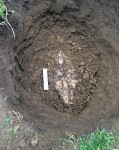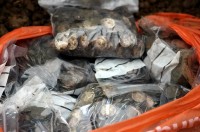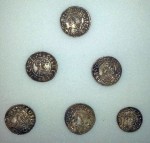 Barely did the year turn before news broke of a new hoard of coins unearthed by metal detectorists in an English field. The finder, Paul Coleman, was scanning farmland near Aylesbury, Buckinghamshire, as part of the Weekend Wanderers Detecting Club‘s yearly Christmas rally when he discovered a piece of lead and a silver coin. When he moved a larger fragment of lead, he saw there were rows of coins underneath. Buckinghamshire Finds Liaison Officer Ros Tyrrell was on site in case something notable was found, so she was able to coordinate a proper excavation after the first few coins were exposed.
Barely did the year turn before news broke of a new hoard of coins unearthed by metal detectorists in an English field. The finder, Paul Coleman, was scanning farmland near Aylesbury, Buckinghamshire, as part of the Weekend Wanderers Detecting Club‘s yearly Christmas rally when he discovered a piece of lead and a silver coin. When he moved a larger fragment of lead, he saw there were rows of coins underneath. Buckinghamshire Finds Liaison Officer Ros Tyrrell was on site in case something notable was found, so she was able to coordinate a proper excavation after the first few coins were exposed.
The area was cordoned off and before an increasingly large crowd of detectorists (there were more than 100 club members at the rally) the find carefully excavated. Silver coins filled a large lead container, apparently a bucket that was folded over at the top to cover the hoard, buried about two feet underground. Portraits on some of the coins identified them as having been minted during the reigns of Ethelred the Unready (reigned 978-1013, 1014-1016 A.D.) and the Danish King Cnute (r. 1016-1035 A.D.).
 As the coins were removed from the soil, they were packed in poly bags and then carried to the farmhouse in an orange Sainsburys plastic shopping bag. On the farm’s kitchen table spread with newspapers, the entire hoard was counted out. The final tally was 5251 silver pennies (plus half of another), one of the largest hoards of Anglo-Saxon coins ever discovered.
As the coins were removed from the soil, they were packed in poly bags and then carried to the farmhouse in an orange Sainsburys plastic shopping bag. On the farm’s kitchen table spread with newspapers, the entire hoard was counted out. The final tally was 5251 silver pennies (plus half of another), one of the largest hoards of Anglo-Saxon coins ever discovered.
After the counting was done, Ros Tyrrell brought the coins that night to the Buckinghamshire County Museum in Halton and the next day they were transported by van to the British Museum. It was December 22nd, so much of the staff was on holiday, but the conservator who was at work immediately set about cleaning and cataloguing the coins. The cleaning process went smoothly, revealing coins in excellent condition. They are shiny, unclipped and so free of wear and tear that it seems likely they were never circulated.
 There was a Royal Mint in Buckingham during the reign of Ethelred within a day’s walking distance from the find site. Given the dates and flawless condition, it’s possible these coins went straight from the mint into the ground, perhaps to hide them from the army of William the Conqueror as it advanced towards the mint.
There was a Royal Mint in Buckingham during the reign of Ethelred within a day’s walking distance from the find site. Given the dates and flawless condition, it’s possible these coins went straight from the mint into the ground, perhaps to hide them from the army of William the Conqueror as it advanced towards the mint.
There will be a coroner’s inquest to determine whether the hoard qualifies as treasure trove which it certainly will since it’s more than 300 years old and made of precious metal. Once declared treasure, a British Museum valuation team will determine its market value and a local museum will be given the opportunity of acquiring the hoard by paying the amount of the valuation. The fee will then be split between the finder and the landowner. Early speculation puts the possible value as high as $390 a coin for a total of $2 million, but that’s just spitballing based on the Ethelred coins. We won’t have solid figures until every coin has been identified and dated.
[youtube=http://youtu.be/lLY1YQbgdwA&w=430]